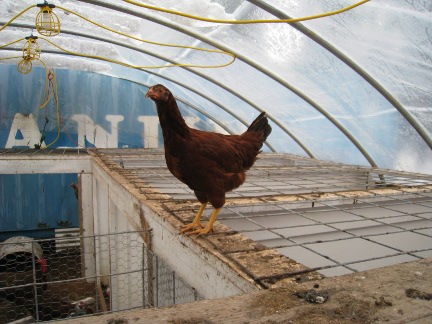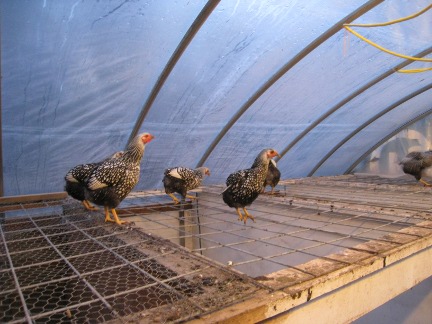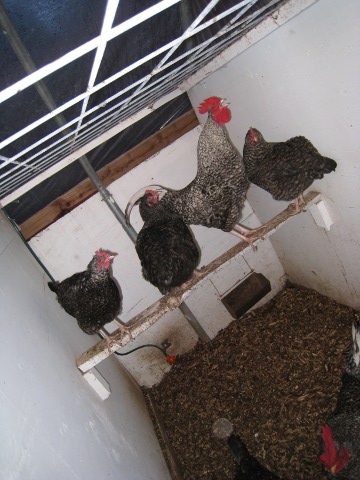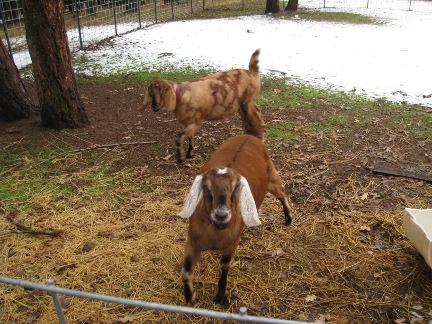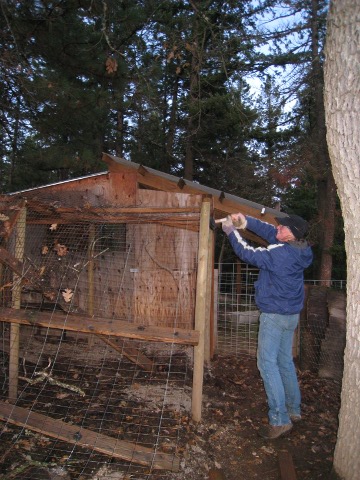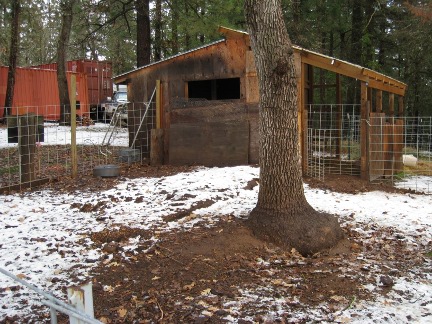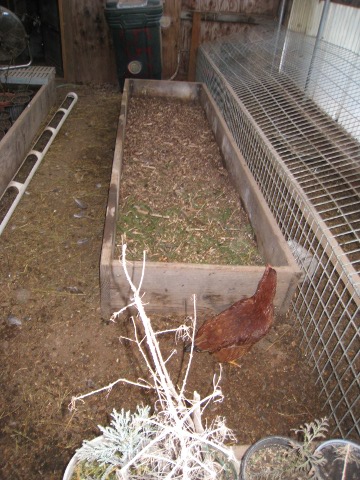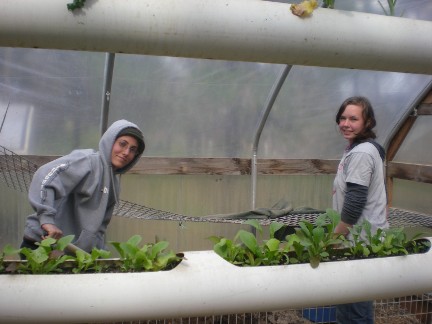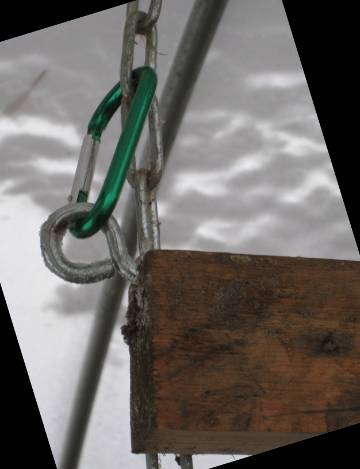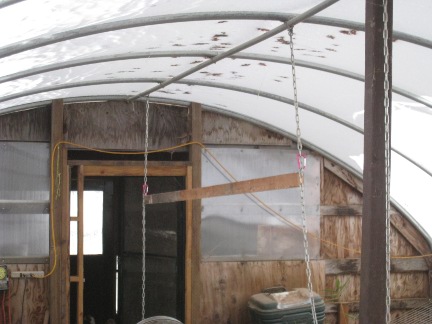Rigging for Winterkaisen time in the chicken coopsOpalyn: With the weather giving us lots of hints that winter weather's just around the corner, we've been focused on rigging our systems for the coming snowy months. In addition to winterizing our living quarters, it's time to perform routine chores such as checking our various work sites to pick up tools that would otherwise be "lost" under the snow until spring.
Applying kaisen, the Japanese principle of continuous improvement, we've been working to improve the housing for our animals, reduce the overcrowding of the chickens from this summer, and make our chores easier. Some of the improvements primarily benefit the animals, while others benefit all of us. The bottom line is that the easier a system is to maintain and operate, the more sustainable it is. One of the rites of fall involves butchering the animals you're not going to over winter. We had intentionally purchased more chicks of each type than we knew we would want to keep, since having extra birds allowed us to pick the best birds for breeding stock and to put the remaining birds in the freezer. As this spring's chicks grew into their full size, the pens were becoming more crowded than we're comfortable with, so the fall butchering benefited the remaining birds by providing them with a lot more room. In preparation for winter, the chickens in the Chic Plex received a new layer of wood chips to help protect them from mites, and of course the garden and orchard benefited from the "nitrogen enriched" wood chips we removed. Next, we hung a set of five compact flouresent lights and set them up on a timer to increase the amount of "daylight" the hens see which increases egg production in the fall and spring. A key part of our approach to sustainability involves working out ways such as this to extend the season. Even so, we've been storing away eggs for the kitchen so that the hens can take a couple of months off to rest up.
Since we won't be saving eggs for incubation until the spring, there's no need to keep the various breeds isolated So, we removed several of the individual pen doors and now all the Rhode Island Reds and Silver-Laced Wyandottes get to run around together. Big birds tend to pick on smaller birds, so we retained a couple of pen doors in order to be able to keep the smaller Araucana Bantams and the larger Cuckoo Marans seperate at least for a while as everyone settles into the new arrangement. We knew that we needed to increase the number of roosting rails but given the birds' enjoyment of roosting on the cattle panels that form the tops of the breeding pens, that's a chore we can leave for next month.
The chickens in Vermadise also received new chips and some slight modifications to their cages. Lindsay is servicing the solar lighting system, and we're planning on increasing Vermadise's roosting space as well. Last spring when we were working to help Jewel deliver the third kid, we felt hemed in so I spent some time attaching hog panels (they're like a cattle panels, only shorter) to the inside of the goat shelter. A cattle panel at the far end is attached to the hog panels with four carabineers, an arrangement which allows us to use that panel as a divider that can quickly rearrange the shape or size of the sheltered space depending on the needs of the moment.
The addition of a frost free faucet near the goat pen means that we will not have to haul hot water from the kitchen to keep fresh water available. The hole for the miniature drain field is nearly complete then we will connect the water line to the faucet and viola - running water.
It's said that history is the store of the best folks could do at the time. Some of the structures that we put up years ago fit that classification. As better structures come online, we're delighted to tear down the old to make way for something better. One such structure was initially built to house a buck then repurposed to house last fall's chickens. With the construction of the chick plex we decided that the old structure was ready to be demolished.
Lindsay and I deconstructed the old coop, starting first by removing the chicken wire and cattle panels. Then we started in on the roof and salvaged several piles of wood and wire which Carina and Sarah helped us load up and put into storage. The pallets we had been put down to keep the birds out of the mud were rotten, so they went up to the burn pile.
Now we have a nice open space adjacent to the goat shelter. Kaisen is fun because we get to see frequent improvements. They may not be evident to new people, but we take satisfaction in watching things track in a positive direction. The road to sustainability is a long journey, and it's these small bits of satisfaction that make the journey fun. December 30: Opalyn: Vermidise has many functions and uses including growing greens, raising rabbits and chickens, earthworm production and our small "starter" aquaponics system. Today, we've been out clearing snow off the roof, transferring nitrogen enriched waste hay to the compost pile, and getting things put away so they are available for use next spring. [Walt: Generally, rabbit urine and chicken manure are too rich in nitrogen for direct application to either earthworms or the garden. To counteract that, we fill the earthworm bins half full of wood chips which also aren't used for direct application because they're too deficient in nitrogen. This way we balance out the surplus in one with the deficit in the other, enabling fungus to rapidly break down the cellulose in the wood chips into food that earthworms can eat.]
Last winter the Guinea Fowl were housed inside vermidise in an enclosed pen. This year we invited them inside without creating the pen and they decided to roost on our PVC grow tubes. We also invited our Indian Runner Ducks inside since their tarp cover split in two and their pond is currently frozen over.
These tubes are designed to be filled with a light-weight mixture of vermiculite, peat moss, and compost. Six guineas trying to roost on them as well were causing them to bow. So I removed the grow tubes and the guineas enjoyed roosting on top of the chicken and rabbit runs.
Yesterday, I headed down to the workshop to create some alternate roosts that should suit the guineas better since they like to roost high enough that a predator like a skunk won't be able to snatch them in the night. I ripped a 10-foot 2x6 in half created two 2x3" roosting bars. A few minutes with a drill and the angled pilot holes were ready for the eye-bolts. The angle of the bolts ensures a strong hold that will also help prevent the roosting bar from spinning when the guineas land on it.
I was going to use the S-hooks that hang the grow tubes but they had been bent around to prevent them from being lost so I got my hands on several carabineers and used them to hang the roosts from the chains that usually support the grow tubes.
The birds usually housed in the chick plex are enjoying roaming the main areas and they flock to each of us as we make our way between our spaces on the chance that we'll have treats for them. Since we won't be looking for eggs to incubate until spring, there's no reason for the hens not to get out and explore. The more active they are in the day, the better they'll handle the cold nights.
Several birds will eat our of our hand and it is entertaining to watch them stand on one foot until it gets cold then switch, pulling the cold foot up under their body to warm it.
|
